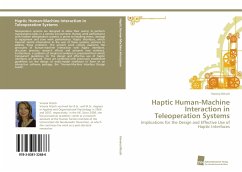Teleoperation systems are designed to allow their user(s) to perform manipulation tasks in a remote environment. Human work performance with modern teleoperation systems is prone to handling errors, damage to equipment and slow work performance. Haptic interfaces, which transmit tactile information to the user of these systems, promise to address these problems. The present work closely examines the principles of human-machine interaction with haptic interfaces, discusses previous research efforts and presents new evidence. Furthermore, a synthesis of empirical evidence is presented from which transparent guidelines for the design and effective use of haptic interfaces are derived. These are combined with previously established guidelines on the design of multi-modal interfaces in form of an interactive software package, the Human-Machine Interface Design Guide".








